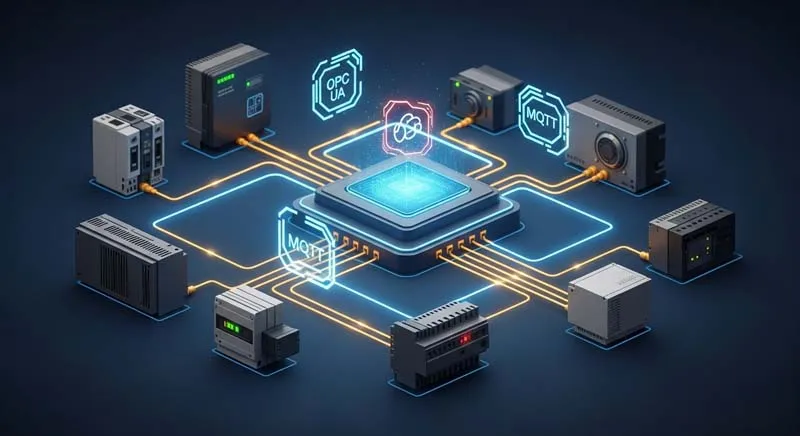
IoT ecosystem collaboration is now shaping the next phase of digital transformation. IoT systems are growing quickly in scale, diversity, and complexity. Because of this, no single company can build end-to-end solutions alone. Customers want systems that are open, scalable, and easy to integrate. As a result, collaboration has become the core engine behind IoT innovation.
Hybrid AI is also rising as a key force that connects data, partners, and applications. Together, they push the industry toward faster breakthroughs.
1. Open Interconnection Becomes the Baseline for Modern IoT
Businesses are expanding IoT deployments across entire operations. Therefore, closed systems no longer meet real needs. Devices from different vendors must work together. Otherwise, data stays isolated, and projects become slow and costly.
Open standards such as OPC UA and MQTT help solve this problem. They create a common language for devices and platforms. Moreover, they encourage companies that used to compete to now cooperate to serve customer demands.
Through this shift, IoT ecosystem collaboration has moved from a strategic option to a basic industry requirement.
2. A Three-Layer Collaboration Model Reshapes the IoT Landscape
To support large-scale deployments, the industry is forming a new collaboration model. It connects hardware makers, software providers, and connectivity services into a shared ecosystem. Each group plays a different but essential role.

1) Hardware Makers Expand Beyond Devices
Modern devices now support open interfaces, lightweight AI, and edge computing. Because of this, they fit into broader platforms with less effort.
2) Software Platforms Work as the System’s Brain
IoT platforms manage data, rules, and applications. In addition, they provide APIs and SDKs that attract partners. This creates an ecosystem in which everyone can contribute.
3) Connectivity Providers Enable Intelligent Data Flow
With 5G, NB-IoT, RedCap, and satellite IoT, communication becomes smarter. Networks start supporting AI-driven data routing and more stable real-time connections.
Therefore, connectivity becomes an important part of the overall ecosystem.
Together, these three groups form a complete value loop:
data → AI insight → action → improvement.
3. Hybrid AI Becomes the Accelerator of IoT Ecosystem Collaboration
AI alone is not enough for complex IoT environments. Instead, hybrid AI brings the flexibility IoT requires.

1) Why Hybrid AI Works Better
Industrial systems need quick, local decisions. At the same time, they need high-level reasoning. Because of this, hybrid AI combines:
- large models for deep insight
- small models for edge decisions
- rules for stable control
This blend allows AI to operate reliably across different conditions.
2) Collaboration Makes Hybrid AI More Effective
Hybrid AI depends on shared data. Without collaboration, data remains locked inside isolated systems. With collaboration, however, data moves freely.
As a result, AI can keep improving. Partners can also reuse AI modules, which speeds up project delivery.
This model reduces Time-to-Market and helps the entire industry move faster.
4. Ecosystems Redefine Competition and Growth
As IoT becomes more connected, the industry is shifting from product competition to ecosystem competition.
Companies with stronger collaboration networks gain more market influence.
1) Supply Chains Become Network-Based
Partners connect through shared data, shared standards, and shared platforms.
This creates a flexible system that grows more quickly.
2) Data Becomes the Most Valuable Asset
The company that controls richer and cleaner data flows can build better AI and better services.
Therefore, data ecosystems become new competitive barriers.
3) Innovation Becomes More Accessible
Because capabilities are modular, smaller companies can join ecosystems more easily.
This allows new solutions to appear faster and scale wider.
Therefore, IoT ecosystem collaboration is becoming the foundation for long-term industrial value.
5. Collaboration and Hybrid AI Drive the Next Stage of IoT
In conclusion, IoT ecosystem collaboration is now the main direction for the IoT industry. It helps break technical barriers and speeds up system integration. Hybrid AI adds even more strength. It improves data use, enhances decision-making, and raises overall efficiency.
In the future, competition will shift from “company vs. company” to “ecosystem vs. ecosystem.”

As a result, open cooperation and shared innovation will lead the next decade of IoT growth.
During this evolution, several leading companies help move the industry forward. EELINK Communication is one of them. The company has more than twenty years of experience in wireless communication and IoT development. Its products cover temperature and humidity monitoring, asset tracking, vehicle security, insurance services, and cold-chain management.
EELINK Communication focuses on solving real customer problems with reliable and efficient technologies. Through continuous innovation, it contributes to the broader vision of connecting everything through smart and scalable IoT solutions.
